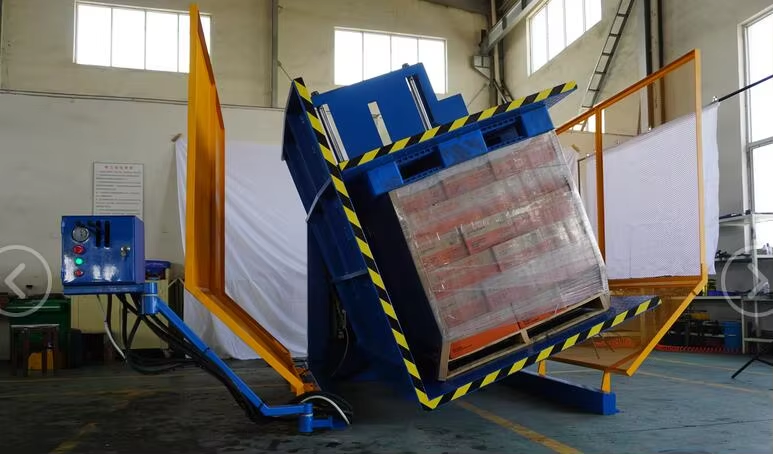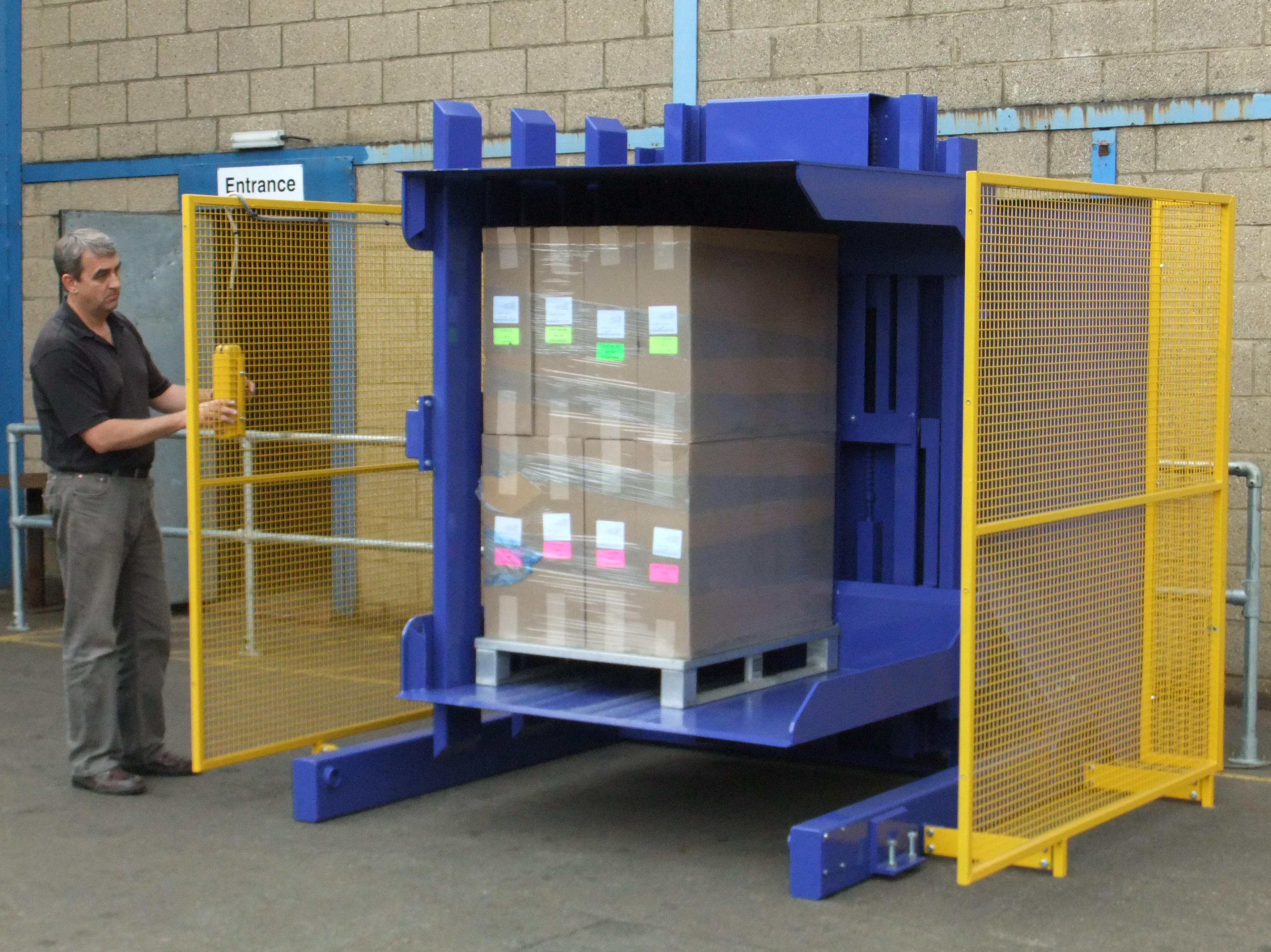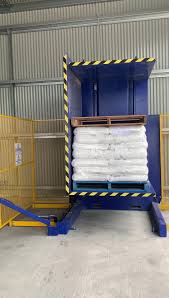From Manual to Smart: Pallet Inverters Transforming Canada's Material Handling
Are your warehouse operations being held back by slow, risky, and outdated processes? Many Canadian businesses still rely on manual restacking to deal with damaged pallets or to transfer goods. This manual labor is not just slow; it introduces significant risks of product damage, creates workplace safety hazards, and forms a major bottleneck in the supply chain. I've seen it countless times: a single damaged pallet brings an entire shipping operation to a standstill, costing time and money. This inefficiency is a silent profit killer that many companies overlook.
Pallet inverters are transforming material handling in Canada by automating the process of transferring loads between pallets. These machines securely clamp a full pallet load, rotate it 180 degrees, and allow for the quick and safe replacement of the bottom pallet. This shift from manual labor to smart automation drastically reduces handling times, minimizes product damage, and significantly improves worker safety, directly boosting a facility's overall efficiency and throughput.

Throughout my journey, from an engineer on the factory floor to owning my own packing machine factory, I've learned a crucial lesson: efficiency is everything. Small improvements in key processes can lead to huge gains in productivity and profitability. The transition from manual to automated solutions, like adopting a pallet inverter, is one of the most impactful changes a modern facility can make. It’s not just about buying a new piece of equipment; it’s about rethinking your workflow for the better. Let's explore how this technology can specifically benefit your Canadian operations.
How do Pallet Inverters Boost Operational Efficiency?
Does your team spend hours each day manually restacking goods from one pallet to another? This is a common scene in many warehouses, a process that is slow, physically demanding, and prone to errors. This manual handling creates a major bottleneck, delaying shipments and tying up valuable staff who could be focused on more productive tasks. Every minute spent restacking is a minute lost in your operational timeline, directly impacting your ability to meet deadlines and manage costs.
A pallet inverter boosts operational efficiency by replacing a time-consuming manual task with a rapid, automated process that takes as little as 60 seconds. This automation frees up employees, reduces bottlenecks, minimizes the risk of product damage during transfer, and allows for quicker turnaround of goods. It enables a smoother, faster, and more predictable workflow, directly increasing the overall throughput of your facility.

When I started my first factory, our cash flow was tight. Every dollar and every minute counted. We had a recurring issue with pallets getting damaged during transport from a supplier. Our team would have to stop everything and manually unload a 1,000 kg pallet of steel components onto a new, good pallet. It was a 30-minute, two-person job that happened multiple times a week. It killed our momentum. Investing in our first pallet inverter was a game-changer. That 30-minute, two-person job became a one-minute, one-person task. The efficiency gain wasn't just incremental; it was transformative. It allowed us to re-assign one of those workers to a value-added role and cleared a major bottleneck in our receiving department. This is the kind of practical, immediate impact these machines deliver.
Diving Deeper into Efficiency Gains
The efficiency improvements from a pallet inverter go beyond just speed. They create a ripple effect across your entire operation, touching on labor allocation, space utilization, and process integrity. Let's break down the comparison between a manual process and an automated one with a pallet inverter.
Labor and Time Optimization
Manual pallet swapping is incredibly labor-intensive. It requires at least two workers and a significant amount of time, depending on the product. The process is repetitive and non-ergonomic, leading to worker fatigue and a higher chance of errors or accidents as the day goes on. A pallet inverter condenses this entire task into a simple, automated cycle. A single operator can manage the entire process using a forklift to load and unload the machine. This reclaims hundreds of man-hours per year that can be redirected toward quality control, inventory management, or order fulfillment.
Space and Workflow Enhancement
Think about the physical space required for manual restacking. You need a large, clear area to break down the pallet, stack the goods, and then rebuild the new pallet. This space is often cordoned off for safety, consuming valuable floor real estate. A pallet inverter has a compact, defined footprint. It integrates cleanly into your existing workflow, often at the end of a production line or in the receiving/shipping bay. This structured approach makes your layout more organized and your process flow more logical and efficient.
| Metric | Manual Pallet Exchange | Pallet Inverter Exchange |
|---|---|---|
| Time per Pallet | 20-40 minutes | 1-2 minutes |
| Labor Required | 2-3 workers | 1 operator (forklift driver) |
| Risk of Product Damage | High (multiple touchpoints) | Very Low (load is clamped) |
| Floor Space Required | Large, open area | Small, defined footprint |
| Process Consistency | Low (depends on workers) | High (repeatable machine cycle) |
This table clearly shows the stark difference. For a business leader like Javier Morales, who aims to increase equipment uptime to 95%, eliminating such unpredictable manual processes is essential. A pallet inverter provides the predictability and reliability needed to achieve such ambitious operational targets. It turns a variable, high-risk task into a fixed, low-risk part of your automated system.
What are the Key Safety Benefits of Using a Pallet Inverter?
Are you concerned about the high rate of back injuries and musculoskeletal disorders (MSDs) in your facility? Manual handling of heavy, awkward loads is one of the leading causes of workplace injuries across Canada. The repetitive bending, lifting, and twisting required to restack a pallet puts immense strain on an employee's body. These injuries lead to lost workdays, increased workers' compensation premiums, and a negative impact on team morale. The risk is always present, and a single bad lift can result in a long-term disability for a valued employee.
The primary safety benefit of a pallet inverter is the near-total elimination of manual lifting and handling during the pallet exchange process. By securely clamping and rotating the entire load, the machine does all the heavy work. This drastically reduces the risk of back strain, muscle tears, and other musculoskeletal injuries. It creates a safer work environment, helps companies comply with provincial occupational health and safety regulations, and protects your most valuable asset: your people.

Early in my career as an engineer, I worked alongside a man named David. He was one of the strongest guys on the floor, and he took pride in his work. His job often involved restacking heavy boxes. One afternoon, he twisted the wrong way while lifting a box from a low pallet, and he herniated a disk in his lower back. He never returned to that job. That event stuck with me. When I founded SHJLPACK, I vowed to create solutions that prevent stories like David's. A pallet inverter is more than a piece of machinery; it's a tool for protecting people. It's an investment in the long-term health and well-being of your workforce.
A Deeper Look at Workplace Safety
Focusing on safety isn't just about compliance; it's a cornerstone of a well-run, profitable business. A safer workplace is a more productive workplace. Let's explore the specific safety improvements a pallet inverter introduces.
Reducing Musculoskeletal Disorders (MSDs)
MSDs are the most common type of lost-time injury in Canada. They are often caused by the exact motions involved in manual stacking: lifting, carrying, bending, and twisting. A pallet inverter removes these hazardous motions from the job description. The employee's role shifts from manual laborer to machine operator, a position that is significantly less physically demanding. This proactive approach to ergonomics is the most effective way to reduce MSD-related incidents and their associated costs.
Preventing Accidents from Unstable Loads
When a pallet is being manually unstacked and restacked, the load is inherently unstable at various points. Boxes can topple, bags can shift, and stacked items can fall, posing a direct threat to workers in the area. A pallet inverter holds the entire load under controlled hydraulic pressure within a sturdy steel frame throughout the entire rotation. The product never becomes unstable, eliminating the risk of falling objects and the catastrophic accidents they can cause.
| Safety Hazard | Manual Pallet Exchange | Pallet Inverter Exchange |
|---|---|---|
| Back/Shoulder Strain | Very High | Eliminated |
| Repetitive Strain Injury | High | Eliminated |
| Falling Object Risk | Moderate to High | Eliminated |
| Trips and Slips | Moderate (cluttered area) | Low (defined work zone) |
| Worker Fatigue | High | Low |
For a leader like Javier, who manages a large workforce in a heavy industry, safety is not negotiable. Implementing engineering controls like a pallet inverter is a fundamental step. It demonstrates a commitment to employee welfare that improves morale, reduces turnover, and ultimately builds a stronger, more resilient company culture. It's a clear signal to your team that their health and safety are a top priority.
How to Choose the Right Pallet Inverter for Your Canadian Facility?
Faced with different models, load capacities, and features, do you know how to select the perfect pallet inverter for your specific needs? Choosing the wrong machine can be a costly mistake. An undersized unit could fail under your typical loads, while an oversized one wastes money and valuable floor space. Without a clear understanding of your operational requirements, you risk investing in a solution that doesn't solve your problem, or worse, creates new ones.
To choose the right pallet inverter, you must first conduct a thorough analysis of your specific needs. This involves evaluating four key areas: your load characteristics (weight, size, type), your facility's physical constraints (space, power), your operational requirements (speed, loading method), and any special environmental factors, such as those found in many Canadian facilities. A systematic approach ensures you select a machine that integrates seamlessly and delivers maximum value.

I've helped many clients navigate this selection process. One client in the food industry in Alberta was ready to buy a standard 180-degree inverter. But after we talked, I learned they only needed to exchange CHEP pallets for in-house pallets, and their loads were sensitive to full inversion. We instead selected a 90-degree pallet tipper, which was faster for their process, gentler on their product, and less expensive. This is what I mean by being a "Total Solution" provider. It's not about selling the most expensive machine; it's about sharing knowledge to find the right machine.
A Systematic Guide to Selection
Choosing a pallet inverter is a significant capital investment. It deserves a careful and methodical decision-making process. As an engineer, I believe in breaking down complex problems into manageable parts. Here’s a framework to guide your choice.
Step 1: Analyze Your Load
The product itself is the most important factor.
- Weight & Dimensions: What is the maximum weight of your heaviest pallet? What are the length, width, and height of your tallest load? You need a machine with a load capacity and opening range that can safely handle your largest and heaviest configurations.
- Product Type: Are you handling robust steel coils, fragile boxes of glass, or unstable bags of powder? The type of product determines the clamping pressure needed. Sensitive loads may require adjustable pressure controls to prevent crushing.
- Pallet Type: What kinds of pallets are you using? Standard wooden pallets, plastic pallets, CHEP rental pallets? The machine's loading tables must be compatible.
Step 2: Assess Your Facility
The machine must fit into your environment.
- Footprint: How much floor space do you have available? Measure the area carefully and account for the necessary clearance for a forklift to approach and maneuver safely.
- Loading Method: How will you load the machine? Most are forklift-loaded, but some models are designed with a low-profile base for pallet jack loading, which can be useful in tighter spaces.
- Power Supply: What are your available utilities? Most inverters run on 3-phase electrical power. Ensure your facility can provide the required voltage and amperage.
- Canadian Climate: Will the machine be used in a cold storage freezer or a non-heated part of a warehouse? Extreme cold can affect hydraulic fluid viscosity and component performance. Special hydraulic oils or heaters may be required for reliable operation in harsh Canadian winters.
| Feature to Consider | Question to Ask | Why It Matters |
|---|---|---|
| Capacity (kg) | What is our absolute heaviest pallet load? | Safety and machine longevity. Never exceed capacity. |
| Opening Range (mm) | What is our tallest possible pallet load? | Ensures the load will physically fit in the machine. |
| Rotation Angle | Do we need 180° inversion or just 90° tipping? | 90° can be faster and better for some products. |
| Loading Style | Forklift or Pallet Jack? | Determines machine model and integration with workflow. |
| Clamping Pressure | Are our products fragile? | Adjustable pressure prevents product damage. |
This systematic approach demystifies the selection process. By answering these questions, you move from uncertainty to clarity, ensuring the pallet inverter you choose is a perfect fit for your Canadian facility, your products, and your operational goals.
What is the Real ROI of a Pallet Inverter Beyond Just Labor Savings?
When you look at the price tag of a new pallet inverter, is your first thought only about how many employee hours it will save? Many business owners make the mistake of calculating the return on investment (ROI) based solely on reduced labor costs. This narrow view fails to capture the full financial impact of the investment. If you overlook the other benefits, you might underestimate the machine's true value and pass on an opportunity to significantly improve your bottom line.
The real ROI of a pallet inverter is a composite of multiple financial benefits. While direct labor savings are significant, the true value also includes drastic reductions in costs from product damage, lower insurance premiums due to a safer workplace, increased throughput capacity which translates to higher revenue potential, and improved management of expensive rental pallets. It is a multi-faceted return that impacts several areas of your operational budget.

I always advise my clients, especially pragmatic leaders like Javier Morales, to look at capital equipment through a wide-angle lens. Don't just ask, "How long until it pays for itself in labor?" Instead, ask, "How does this investment help us achieve our strategic goals?" Javier's goal is to lower overall operational costs by 8%. A pallet inverter contributes to that goal from many directions, not just one. It reduces waste (damaged product), lowers risk (safety costs), and increases capacity (efficiency). This is how you build a robust business case that goes beyond a simple payback calculation and justifies the investment on a strategic level.
Calculating the Comprehensive ROI
A proper feasibility analysis, like the ones Javier insists on, must account for both direct (tangible) and indirect (intangible) returns. The true power of this investment is revealed when you quantify all its benefits.
Tangible Financial Returns
These are the benefits you can easily calculate and see on your profit and loss statement.
- Labor Savings: This is the most obvious. Calculate the hours per day spent on manual stacking, multiply by the number of workers and their burdened wage rate. The pallet inverter reduces this cost by over 90%.
- Product Damage Reduction: Track your current rate of product damage during handling. Even a 1% reduction in damage for a high-value product can result in thousands of dollars saved annually. The inverter's secure clamping mechanism virtually eliminates this type of damage.
- Rental Pallet Cost Management: Companies using pallet rental programs (like CHEP or PECO) can quickly transfer goods to cheaper, one-way shipping pallets for outbound loads, returning the expensive rental pallets immediately. This accelerates the cycle and reduces rental fees.
- Workers' Compensation Savings: A safer workplace with fewer injuries leads directly to lower insurance premiums. While harder to quantify upfront, a single prevented MSD claim can save tens of thousands of dollars.
Strategic and Intangible Value
These benefits are harder to assign a specific dollar value to, but they are crucial for long-term success.
| Benefit Category | Manual Process Impact | Pallet Inverter Impact | Strategic Goal Supported |
|---|---|---|---|
| Tangible: Cost | High labor & damage costs | Drastically reduced costs | Lowering overall operating costs by 8%+ |
| Tangible: Speed | Slow, unpredictable bottleneck | Fast, consistent cycle time | Increasing capacity utilization to 95% |
| Intangible: Safety | High risk of MSDs | Very low physical risk | Improving workplace safety and morale |
| Intangible: Quality | Risk of contamination/damage | Preserves product integrity | Enhancing brand reputation and quality |
Investing in a pallet inverter is a key step in a facility's digital transformation journey. It is a piece of smart hardware that automates a critical physical process, laying the groundwork for more advanced logistics systems. For a leader aiming to build a modern, efficient, and resilient operation, the comprehensive ROI of a pallet inverter makes it one of the most compelling investments available.
Conclusion
Pallet inverters are a strategic investment for modern Canadian warehouses, boosting efficiency, safety, and profitability. They are a cornerstone of smart material handling.


![[Engineer’s Guide] How to Choose the Right Mold Flipper for Your Workshop? [Engineer’s Guide] How to Choose the Right Mold Flipper for Your Workshop?](https://i2.wp.com/res.cloudinary.com/dheixzr6f/image/upload/v1741318561/pallet_inverter_for_supply_chain_optimization_n0foza.jpg?w=640&resize=640,479&ssl=1)
